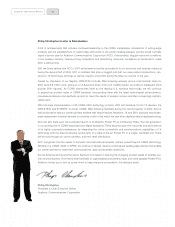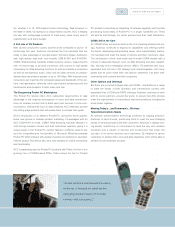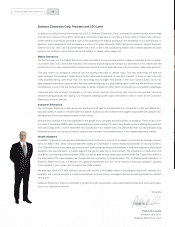Audiovox 2001 Annual Report Download - page 15
Download and view the complete annual report
Please find page 15 of the 2001 Audiovox annual report below. You can navigate through the pages in the report by either clicking on the pages listed below, or by using the keyword search tool below to find specific information within the annual report.
Forward-Looking Statements
This Annual Report contains forward-looking statements within the
meaning of Section 27A of the Securities Act of 1933 and Section 21E
of the Securities Exchange Act of 1934. Words such as “may,”
“believe,” “estimate,” “expect,” “plan,” “intend,” “project,” “anticipate,”
“continues,” “could,” “potential,” “predict” and similar expressions may
identify forward-looking statements. The Company has based these
forward-looking statements on its current expectations and projections
about future events, activities or developments. The Company’s actual
results could differ materially from those discussed in or implied by
these forward-looking statements. Forward-looking statements include
statements relating to, among other things:
• growth trends in the wireless, automotive and consumer electronic
businesses
• technological and market developments in the wireless, automotive
and consumer electronics businesses
• liquidity
• availability of key employees
• expansion into international markets
• the availability of new consumer electronic products
These forward-looking statements are subject to numerous risks,
uncertainties and assumptions about the Company including, among
other things:
• the ability to keep pace with technological advances
• significant competition in the wireless, automotive and consumer
electronics businesses
• quality and consumer acceptance of newly introduced products
• the relationships with key suppliers
• the relationships with key customers
• possible increases in warranty expense
• the loss of key employees
• foreign currency risks
• political instability
• changes in U.S. federal, state and local and foreign laws
• changes in regulations and tariffs
• seasonality and cyclicality
• inventory obsolescence and availability
The Company markets its products under the Audiovox brand name as
well as private labels to a large and diverse distribution network both
domestically and internationally. The Company operates through two
marketing groups: Wireless and Electronics. Wireless consists of
Audiovox Communications Corp. (ACC), a 95%-owned subsidiary of
Audiovox, and Quintex, which is a wholly-owned subsidiary of ACC.
ACC markets wireless handsets and accessories on a wholesale basis
to wireless carriers primarily in the United States and, to a lesser
extent, carriers overseas. Quintex is a small operation for the direct
sale of handsets, accessories and wireless telephone service.
The Electronics Group consists of two wholly-owned subsidiaries,
Audiovox Electronics Corporation (AEC) and American Radio Corp.,
and three majority-owned subsidiaries, Audiovox Communications
(Malaysia) Sdn. Bhd., Audiovox Holdings (M) Sdn. Bhd. and Audiovox
Venezuela, C.A.The Electronics Group markets automotive sound and
security systems, electronic car accessories, home and portable
sound products, FRS radios, in-vehicle video systems, flat-screen tele-
visions, DVD’s and navigation systems. Sales are made through an
extensive distribution network of mass merchandisers, power retailers
and others. In addition, the Company sells some of its products directly
to automobile manufacturers on an OEM basis.
The Company allocates interest and certain shared expenses to the
marketing groups based upon both actual and estimated usage.
General expenses and other income items that are not readily alloca-
ble are not included in the results of the two marketing groups.
From fiscal 1996 through 2001, several major events and trends have
affected the Company’s results and financial conditions.
Wireless increased its handset sales from 2.1 million units in fiscal
1996 to an all-time high of 8.9 million units in fiscal 2000 back to
7.0 million units in 2001. This overall growth in unit sales from 1996
was primarily due to:
• the introduction of digital technology, which has allowed carriers to
significantly increase subscriber capacity
• reduced cost of service and expanded feature options
During this period, Wireless’ unit gross profit margin declined due
to continued strong competition. Wireless’ gross margin dollars has
significantly increased overall due to the overall large increases in
net sales.
Sales by the Electronics Group were $188.4 million in 1996 and
$193.9 million in 1997, but declined in 1998 to $185.0 million, primarily
due to the financial crisis in Asia, particularly Malaysia. Sales for fiscal
1999, fiscal 2000 and fiscal 2001 were $242.5 million, $278.3 million
and $301.0 million, respectively. During this period, the Company’s
sales were impacted by the following items:
• the growth of our consumer electronic products business from
$2.9 million in fiscal 1996 to $81.2 million in fiscal 2001
• the introduction of mobile video entertainment systems and other
new technologies
• the Asian financial crisis in 1998
• growth of OEM business
Gross margins in the Company’s electronics business increased from
18.9% in 1996 to 20.3% for fiscal 2001 due, in part, to higher margins
in mobile video products, other new technologies and products and
the growth of the international business.
Management’s Discussion and Analysis of Financial
Condition and Results of Operations
13 Audiovox Corporation and Subsidiaries
























